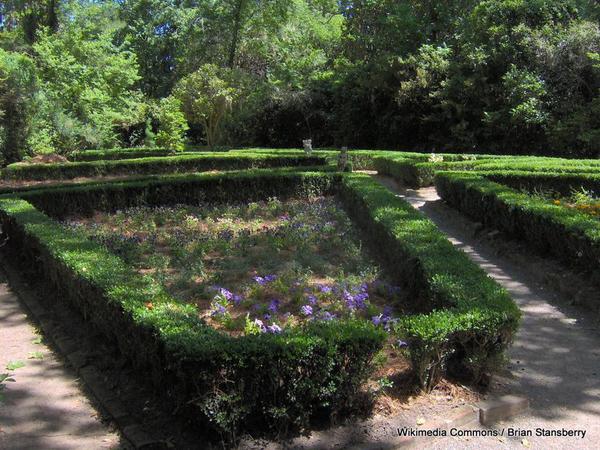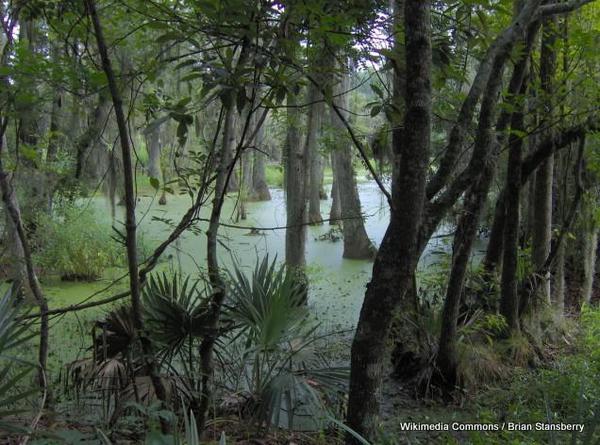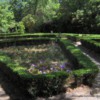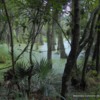This story started out simple: A visit to a beautiful riverside plantation, renowned for its centuries-old formal gardens. But the past is usually not so simple, and in this instance involves not only the ugly story of the slavery that made planters wealthy, but also the conflicted story of this plantation's owners and their own conflicts over slavery.
Magnolia's story begins in 1676, when Thomas and Ann Drayton built a house and formal garden on the site; the Flowerdale section above is part of this oldest continuing garden in the Americas. Then came the search for a crop that could succeed in the area. Within a few years, African slaves from rice-growing areas of Africa had turned Magnolia into a successful rice plantation, with dikes and dams along the Ashley River.
Rice made the Draytons' fortune, an immense one, and the plantation eventually covered 2000 acres. The Draytons lived well in a large plantation mansion and an elegant Charleston town house. The slaves lived a lot less well, in rickety cabins, with several families crammed into spaces so small that the inside was mostly used only for sleeping and cooking, with other activities outside.
These restored/preserved cabins open to visitors are from 1850 on; as grim as they are they represent an "upgrade." Note the newspapers—anything to line the walls and cover the cracks against the wind.
But the Draytons, whose family still own the plantation today, were not entirely typical slave-owning planters, either. In the 1840s, John Grimke, grandson of a Drayton, inherited the plantation from his grandfather, on condition he take the Drayton name. His father was the brother of early Quaker abolitionists Sarah Grimke and Angelina Grimke, who were driven out of South Carolina because of their Abolitionist campaigns.
Grimke-Drayton himself was an Episcopal priest as well as an avid gardener, who greatly extended and updated the formal gardens—and also secretly and illegally built a small schoolhouse where he taught slave children to read and write. To avoid upsetting his congregation he claimed to be teaching only religion. I told you, the story's complicated.
Now we move ahead to after the Civil War. The Draytons were in North Carolina, a summer retreat, and the house at Magnolia was burned. Much of the rice-producing fields had been badly damaged. A former slave, Adam Bennett, who had been one of the main gardeners, walked to North Carolina to tell the Draytons what had happened. When the Draytons returned and began to rebuild, Bennett, and his family after, became the superintendents of the gardens.
Because of wartime damage (and the loss of slave labor, to be honest) the plantation never returned to reliance on agriculture. Instead, in 1870, the gardens were opened to tours, practically inventing a new tourist industry. It's still what pays the bills.
In the 1920s, another family, the Leaches, took over the garden superintendency; four generations later, they are still the mainstay of garden maintenance and cultivataion. And until 1969, they lived in one of these former slave cabins.
As for the plantation house itself, it's certainly not the typical ante-bellum plantation house with the high first floor and graceful columns. Not like that at all. After the war, Drayton couldn't afford to rebuild, and instead floated an old hunting cabin down the river and lived in it. That's the part on the left. The columns and porches and the fancier larger rooms on the right were added by his daughter Julia, the only woman owner ever.
As recently as the 1930s, the Draytons planned to pull the house down and build a huge and elegant mansion in its place, but the Depression made it seem tasteless to do so, and the project was dropped. Instead, by 1975 the Draytons decided to let the house be part of the tour, and moved to other, more modern quarters.
The grounds, nearly 400 acres, are filled with old and new plantings, with formal gardens and a swamp garden named for Audubon, who was an early visitor here, and much more. It's about a 45-minute drive from Charleston—and well worth the trip.





Comments (4)